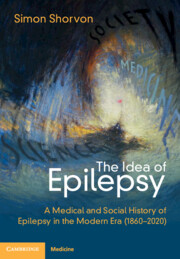Book contents
- The Idea of Epilepsy
- The Idea of Epilepsy
- Copyright page
- Dedication
- Contents
- Preface
- Section 1 The Voyage Of The Good Ship Epilepsy
- Section 2 ‘A Plague upon Your Epileptic Visage’
- One 1860–1914: The Birth of Modern Epilepsy
- Two 1914–1945: Epilepsy in the Age of Catastrophe
- Three 1945–1970: Epilepsy and the New World Order
- Four 1970–1995: Epilepsy in a Globalised World
- Five 1995–2020: The Epilepsy Floods are Too Recent
- Section 3 Epilepsy: The Paradigm of the Suffering of Both Body and Soul in Disease
- Book part
- Glossary
- Bibliography
- Index of Names
- Index
Four - 1970–1995: Epilepsy in a Globalised World
from Section 2 - ‘A Plague upon Your Epileptic Visage’
Published online by Cambridge University Press: 13 January 2023
- The Idea of Epilepsy
- The Idea of Epilepsy
- Copyright page
- Dedication
- Contents
- Preface
- Section 1 The Voyage Of The Good Ship Epilepsy
- Section 2 ‘A Plague upon Your Epileptic Visage’
- One 1860–1914: The Birth of Modern Epilepsy
- Two 1914–1945: Epilepsy in the Age of Catastrophe
- Three 1945–1970: Epilepsy and the New World Order
- Four 1970–1995: Epilepsy in a Globalised World
- Five 1995–2020: The Epilepsy Floods are Too Recent
- Section 3 Epilepsy: The Paradigm of the Suffering of Both Body and Soul in Disease
- Book part
- Glossary
- Bibliography
- Index of Names
- Index
Summary
The basic science of epilepsy made fundamental advances in this period, with the discovery of GABA as the chief inhibitory transmitter and glutamate as the chief excitatory transmitter involved in epilepsy. This spurred intensive research by the pharmaceutical companies and the introduction of a range of new drug treatments, although none were shown to be of superior efficacy to those already existing. Extraordinary progress was made also in the basic science of genetics, although this did not feed into clinical epilepsy. The major investigational advances were CT and then MRI scanning, which transformed clinical practice in epilepsy, and also EEG technologies allowing prolonged monitoring and video-EEG correlation. The number of clinical researchers in epilepsy greatly increased, stimulated by changing university and hospital priorities and the technological advances of the computing era. Advances were made in many clinical fields in epilepsy, including epidemiology, paediatrics, epilepsy syndromes, febrile convulsions and their relationship to temporal lobe epilepsy, SUDEP and status epilepticus. Aided by therapeutic drug monitoring, antiseizure drug monotherapy became commonplace. New drugs and new surgical techniques were introduced. An attempt was made to federate ILAE and IBE under the umbrella of a new organisation, Epilepsy International, but this failed.
Keywords
- Type
- Chapter
- Information
- The Idea of EpilepsyA Medical and Social History of Epilepsy in the Modern Era (1860–2020), pp. 396 - 497Publisher: Cambridge University PressPrint publication year: 2023

